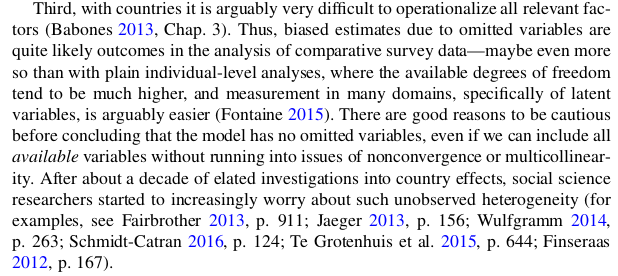Working with repeated comparative survey data – almost a howto
There is now a bonanza of studies that rely on surveys which are replicated across countries and time, often with fairly short intervals, with the ESS arguably one of the most prominent examples (but also see the “barometer” studies in various regions). Multi-level analysis is now the weapon of choice to tackle these data, but the appropriate structure of such models is not immediately obvious: are we looking at waves nested in countries? Countries nested in waves? Or rather at surveys cross-classified by year and country? What’s the role of the small-n problem when we are talking about countries? And does the notion of sampling even make sense when we are talking about what is effectively the whole population of countries that could be studied?
- Schmidt-Catran, A. W., & Fairbrother, M. (2016). The random effects in multilevel models: getting them wrong and getting them right. European Sociological Review, 32(1), 23–38. http://dx.doi.org/10.1093/esr/jcv090
- Schmidt-Catran, A. W., Fairbrother, M., & Andreß, H. (2019). Multilevel models for the analysis of comparative survey data: common problems and some solutions. , 71(1), 99–128. http://dx.doi.org/10.1007/s11577-019-00607-9
What we liked
It’s difficult to have a discussion about a text that provides a lot of factual information about methodological bits and bobs, especially when you have little prior knowledge. Having said that, students found both texts (which are related but complementary) remarkably accessible and helpful.

What we did not like so much
Nothing. Students liked these two. So did I. Period.
Discover more from kai arzheimer
Subscribe to get the latest posts sent to your email.

Glad you enjoyed!